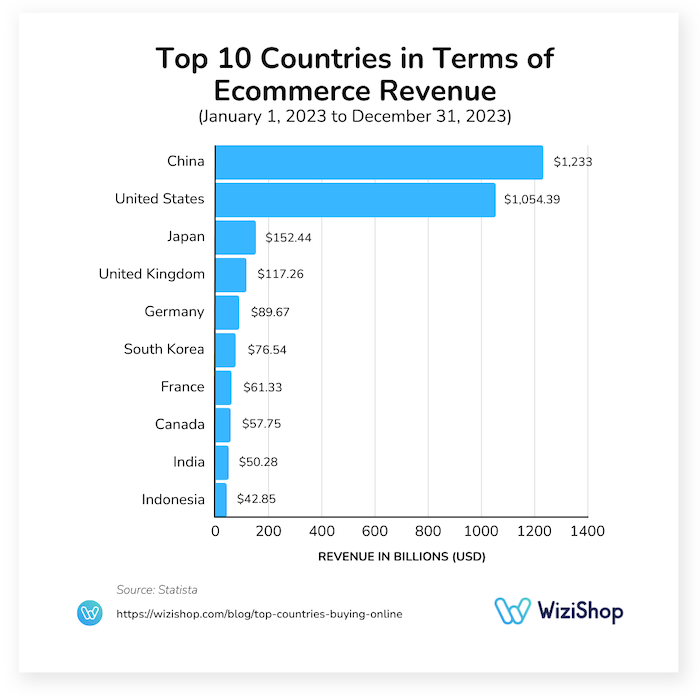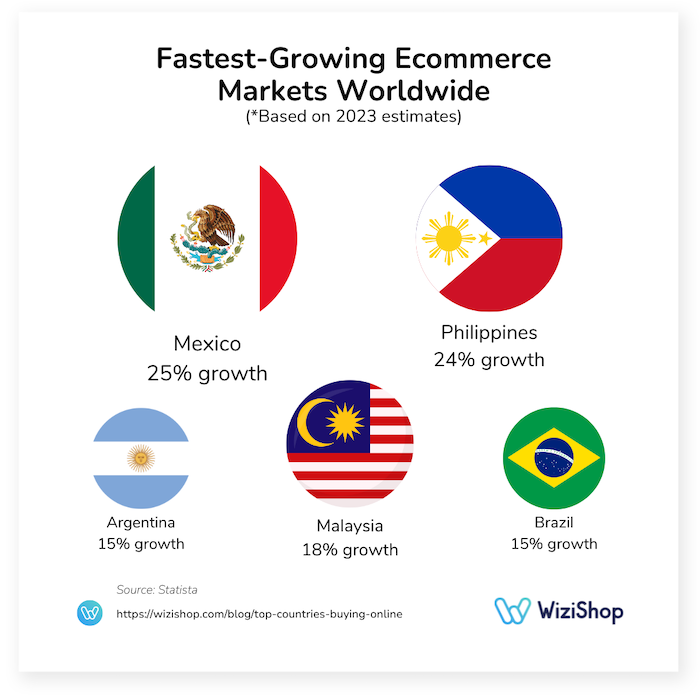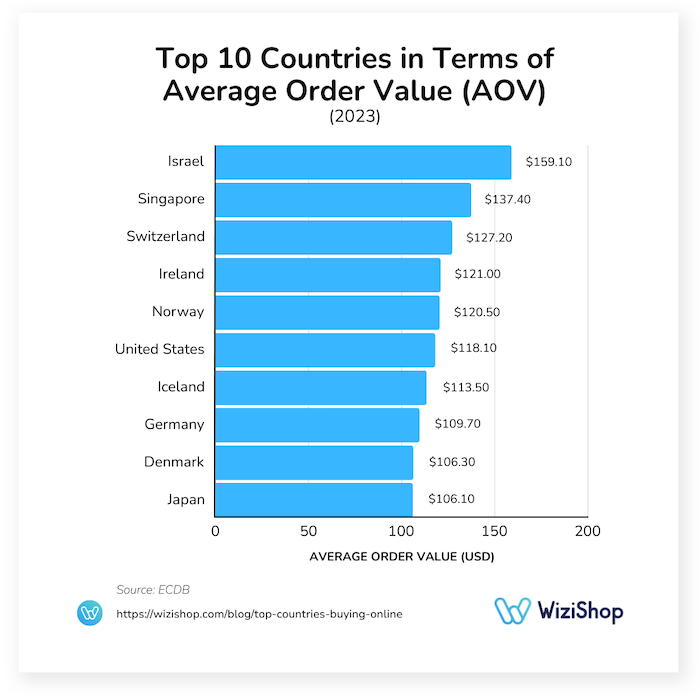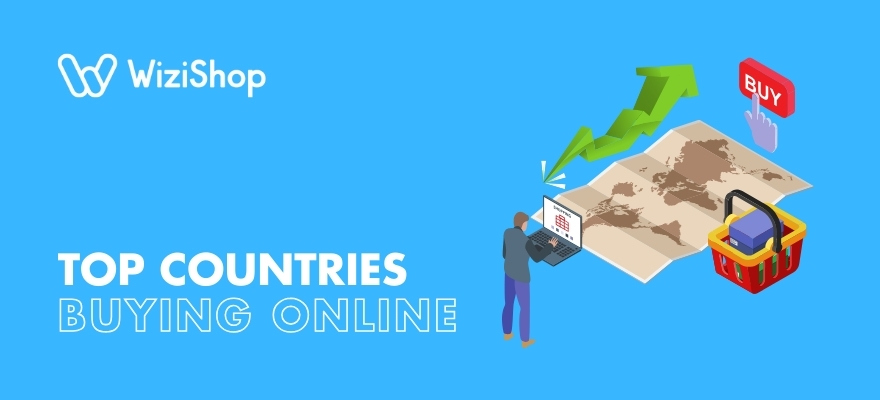There’s been quite a bit of growth in ecommerce worldwide recently, but it's still much more popular in some countries than in others. Online spending varies drastically from region to region, and every internet business should be aware of these differences. Understanding the top ecommerce markets is essential for grasping global economic trends.
This article explores the powerhouse nations that dominate online shopping, analyzing how diverse economic landscapes and consumer behaviors shape their success. From the tech-savvy streets of South Korea to the bustling marketplaces of the United States, we'll take a look at what makes these countries leaders in the ecommerce sector.
Keep in mind that while we focus on revenue in this article, there are all kinds of other ways to measure ecommerce activity. Consumer behavior, including social media usage and ecommerce payment trends, may vary between countries, and some products may be more in demand than others in different regions.
If you’re considering launching your own store, you’ll definitely want to continue to research the market to learn more about your unique niche or industry.
Ready to learn more about the biggest ecommerce markets in the world?
Let's get into it!
What percentage of shopping is done online?
Ecommerce has grown relatively consistently over the years, with a surge in popularity occurring during the height of the COVID-19 pandemic. On a global level, consumers and business alike had to quickly adapt to lockdowns and travel restrictions. Although these restrictions are no longer in place, quite a few shoppers developed an appreciation for the convenience of buying on the internet and continue to head to the web when looking to make a purchase nowadays.
In order to accommodate changing buyer behavior, many traditional brick-and-mortar businesses that had launched an internet presence during the pandemic have opted to keep their online stores open in conjunction with their physical locations or stuck to offering their products or services via web commerce only.
In 2023, online shopping made up 19.4% of total retail sales worldwide, according to Statista. This statistic is predicted to continue increasing in the years to come, reaching 22.6% by 2027. While it's clear that there's still significant demand for shopping in traditional stores, ecommerce is expected to only become more popular as time goes on due to the many benefits it offers both consumers and businesses.
Which countries generate the most e-shopping revenue?
It's no secret that ecommerce has revolutionized the way businesses operate and consumers shop. As the owner (or future owner) of an online store, having a good understanding of which countries are generating the most revenue from online sales can help you better determine where to focus your own strategy and take your business to the next level.
Let's take an in-depth look at the top performers in the ecommerce sector worldwide, highlighting their strategies, market dynamics, and the factors driving their success.

1. China
China’s presence as an ecommerce giant is undeniable, bringing in approximately $1.23 trillion in 2023. The country plays a major role in international ecommerce, with several of the leading and most lucrative internet retailers in the world being headquartered in China.
For example, China is home to Alibaba, one of the biggest international stores on the internet. Alibaba has several important subsidiaries, including AliExpress, Taobao, and Tmall. With all of these subsidiaries combined, Alibaba is a close rival of Amazon when it comes to total revenue.
China's position as a global leader in ecommerce revenue is also largely due to its vast population and high internet penetration rate, which create an enormous consumer base. Moreover, the Chinese government supports digital economy growth, and mobile payment systems like Alipay and WeChat Pay facilitate easy, widespread access to online shopping.
2. United States
The United States is another leader when it comes to online spending due to its strong economic foundations, high consumer spending power, and widespread internet connectivity. With several US-based companies making up the list of the largest online retailers worldwide, it's no surprise that the country takes second place on our list, generating around $1.05 trillion in revenue from internet shopping in 2023.
The leading ecommerce sites in the United States are Amazon, eBay, and Walmart. Although many smaller retailers do well in the States, these three massive retailers dominate the market. Consumers tend to visit these sites especially for purchasing household items and personal care products.
American consumers are tech-savvy and frequently engage in online shopping, supported by a well-established digital payment infrastructure. Based on Statista data, the number of U.S. shoppers is predicted to grow by just under 22% in the next five years, resulting in the country having 333.5 million digital buyers by 2029. Almost all adults in the United States shop on the web at least occasionally. With free and fast shipping becoming commonplace, ecommerce in the US continues to grow year after year.
3. Japan
With a sophisticated technological framework and a culturally ingrained preference for convenience and efficiency in shopping, it's no wonder that Japan can be found high on the list of countries generating the most ecommerce revenue. Although Japan isn’t at the top of the ecommerce industry overall, the country is a global leader in mobile ecommerce.
Japan has a high penetration of internet and smartphone usage, facilitating consumer access to online platforms. Major ecommerce players like Rakuten and Yahoo! Japan provide a diverse array of products and services. Furthermore, Japan's efficient logistics systems ensure rapid delivery, enhancing the overall appeal of online shopping and helping to bring in $152.44 billion in revenue in 2023.
According to ECDB, the highest earning internet retailers in Japan in 2023 were Amazon Japan, Apple, and Yodobashi, generating about $2.46 billion and making up 38.6% of the total market share for the top 100 ecommerce sites in the country.
4. United Kingdom
The United Kingdom comes in a little behind Japan in terms of ecommerce revenue, producing $117.26 billion in 2023.
British consumers are comfortable with making online purchases, facilitated by robust digital payment systems and comprehensive consumer protections. In addition, the United Kingdom benefits from a competitive ecommerce landscape, featuring big names such as Amazon UK and local giants like Tesco and Argos, which drive innovation and provide a wide array of goods and fast delivery options.
Electronics are a particularly in-demand product for online shoppers in the United Kingdom. These citizens also seem to be very careful and thoughtful buyers. Many will view items in brick-and-mortar stores but research prices on the web before they buy from the most cost-effective retail business.
5. Germany
A cornerstone of Europe's ecommerce sector, Germany benefits from a strong logistical framework that supports efficient nationwide and cross-border deliveries. Today, a minimum of 80% of German consumers take advantage of the internet for their shopping needs, according to Ecommerce News Europe.
Germany's strategic location in Europe makes it an ideal hub for ecommerce, allowing for quick and efficient distribution channels across the continent, which likely was a factor that aided the country in generating ecommerce revenue of almost $90 billion in 2023.
Amazon’s regional website for Germany accounts for a significant portion of the online purchases producing these earnings. In addition, eBay is quite prominent in Germany as well.
The country is also home to Otto, one of the largest ecommerce companies in the world. Otto primarily sells clothing, accessories, and lifestyle products. The company is popular both in Germany and throughout the rest of Europe.
6. South Korea
South Korea's leadership in ecommerce revenue is largely attributed to the fact that it boasts some of the fastest connectivity speeds worldwide. This technological advantage facilitates a highly digital lifestyle, with consumers favoring online transactions for their convenience and speed.
The country's compact geography also enhances delivery efficiency, enabling rapid service and fostering greater consumer reliance on web commerce. Furthermore, South Korea's innovative payment solutions and high smartphone penetration rate support a thriving mobile commerce environment.
Major ecommerce platforms like Coupang and Gmarket exemplify how tailored services and user-friendly interfaces drive the ecommerce market's growth and consumer engagement, helping South Korea to earn $76.54 billion in revenue from online shopping in 2023.
7. France
With a culturally ingrained affinity for luxury and specialty goods that translate well to online sales, France has seen a major expansion of internet commerce in recent years, with many people enjoying online purchases from both French and global brands.
Additionally, France benefits from a high internet penetration rate and a consumer base that's increasingly on the lookout for convenience and personalized shopping experiences online.
Amazon’s regional website for France is the most used online shopping platform in the country. Other top French online retail businesses include Cdiscount, which offers a wide variety of electronics, appliances, food, and other items; Fnac, focusing on entertainment and consumer electronics; and Carrefour, the supermarket titan.
There are also plenty of small and mid-sized French websites that have flourished in the last few years, many of which were created with the WiziShop online store builder!
The supportive regulatory framework and strong logistics networks across France also enhance the ecommerce ecosystem, facilitating smooth and timely transactions and generating $61.33 billion in ecommerce revenue in 2023.
8. Canada
Canada's status as a global leader in ecommerce revenue is fueled by its widespread internet access and a culturally diverse population that readily adopts online shopping.
The country's 2023 ecommerce earnings of $57.75 billion can partly be explained by its expansive geography, which makes ecommerce an attractive alternative for remote and urban populations alike, consisting of consumers seeking convenience and variety.
Moreover, Canada's bilingual policy enhances market accessibility and customer service, allowing for tailored shopping experiences. Strong consumer protections and efficient logistics are additional main factors that further drive confidence and growth in the digital marketplace.
In terms of Canada's key players in online sales, Mordor Intelligence figures show that Amazon Canada takes the #1 spot, demonstrating success particularly in the category of computers and electronics. Regional websites for other American brands, such as Walmart and Home Depot are also very popular with Canadian shoppers availing of internet commerce.
9. India
India has emerged as one of the top generators of ecommerce revenue worldwide, earning $50.28 billion in 2023, thanks to a massive, young, and tech-savvy population quickly adopting digital technologies.
The surge in smartphone usage and increasing internet penetration, especially in rural and semi-urban areas, has opened up a vast new consumer base for online markets.
Local big names like Flipkart and Snapdeal, along with the presence of international key players such as Amazon, have tailored their offerings to suit the unique preferences and price sensitivities of Indian consumers.
Government initiatives promoting digital payments have further accelerated ecommerce growth, making online shopping a convenient and preferred choice for millions.
10. Indonesia
Last but not least, Indonesia comes in at #10 on our list of the Top 10 countries generating the most ecommerce revenue worldwide, producing $42.85 billion in 2023.
Indonesia has seen a significant boom in online shopping as of late due to its large and growing population, increasing internet penetration, and a youthful demographic eager to engage digitally. The archipelago's unique geography, with thousands of islands, makes ecommerce an appealing solution for accessing goods and services that might otherwise be difficult to obtain.
Rapid urbanization and rising disposable incomes also contribute to the growth of online shopping in Indonesia. In addition, ecommerce platforms like Tokopedia and Shopee have thrived by offering customers diverse payment options and improving logistics to serve both urban and remote areas efficiently.
Where are internet shopping sales growing the fastest?
Besides learning where the most ecommerce revenue is being generated around the world, it can also be advantageous to understand which countries are seeing the fastest ecommerce growth.
Identifying regions with surging ecommerce activity can guide strategic decisions, from market entry to tailored marketing campaigns, helping to tap into new customer bases and maximize profitability. By exploring these burgeoning markets, businesses can position themselves advantageously in a competitive digital economy.
Based on Statista data concerning where the most retail ecommerce growth was expected to be experienced in 2023, here are the nations where ecommerce expansion is outpacing the rest, offering a window into emerging markets ripe with opportunity.

Asia and the Americas were predicted to be the top regions for ecommerce growth in 2023, with Mexico and the Philippines leading the charge, seeing estimated increases in online sales of approximately 25% and 24%, respectively. Malaysia was set to experience significant growth as well, anticipated at 18%. Argentina and Brazil were also predicted to see substantial rises in e-retail sales, with increases of just over 15%.
This surge is largely driven by the dramatic rise in global internet users in recent years along with the adoption of mobile commerce, particularly prevalent in the global South, where shopping via smartphones has become more and more common.
Where do people spend the most per order when they buy online?
The average sum spent on each online purchase provides a distinctive perspective on the overall condition and trends within global ecommerce markets. This crucial metric, referred to as the average order value (AOV), illuminates aspects of consumer behavior, the maturity of markets, and economic patterns across different regions.
A higher AOV is beneficial, as it indicates stronger consumer spending power and can lead to greater profitability per transaction. Analyzing the top-performing nations in terms of how much customers spend on average per order can help you tailor strategies to attract premium segments and optimize revenue.
So, in which locations is AOV the highest worldwide?

According to ECDB, the nations that had the highest AOV in 2023 include the following:
- Israel: $159.10
- Singapore: $137.40
- Switzerland: $127.20
- Ireland: $121.00
- Norway: $120.50
- United States: $118.10
- Iceland: $113.50
- Germany: $109.70
- Denmark: $106.30
- Japan: $106.30
Remember that AOV can be influenced by a variety of factors, such as product pricing, customer demographics, and the effectiveness of marketing strategies that encourage larger purchases, such as bundling or upselling. Furthermore, seasonal promotions and loyalty programs can significantly alter AOV by enticing shoppers to spend more during specific periods or through repeat purchases.
Global ecommerce: A worldwide love for purchasing online
Comparing the ecommerce industry in different countries can be difficult. Because populations and currencies vary so widely from country to country, there’s no perfect way to measure the popularity of online shopping.
We can examine both ecommerce spending and selling to get a better understanding of the online retail market in any particular region.
In some countries, the primary ecommerce activity comes from shoppers who are spending money online. In other countries, residents spend less money online, but online stores that ship internationally are incredibly successful.
If you live in a country where online shopping is booming, selling locally is probably the wisest choice. However, if consumers in your region aren’t as keen on online shopping, you may want to branch out to international sales.
You should also keep in mind that the ecommerce industry is changing all the time. We’ve seen a steep increase in online shopping in the last decade, but there’s still plenty of room to grow in many countries.
Your country may not be on this list, but that doesn’t mean that the ecommerce industry will never thrive there as the percentage of retail sales found online continues to grow.
Stay informed with the latest data and ecommerce statistics so you don’t miss the perfect opportunity to establish yourself in the ecommerce market and attract even more customers to your online store!










